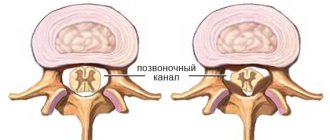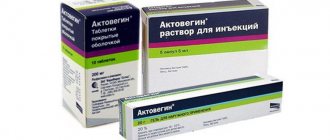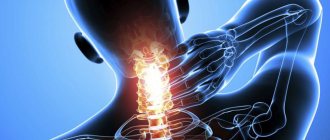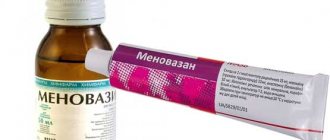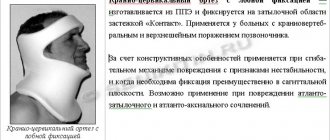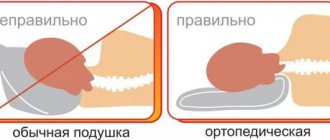September 24, 2019
45589
0
3 out of 5
Vertebral artery syndrome is a collective term that unites a number of different diseases of a vascular, vestibular, traumatic, vegetative nature, accompanied by a narrowing of one or both vertebral arteries. This is accompanied by painful migraines, impaired hearing, vision, consciousness and can lead to stroke, disability, irreversible damage to the brain and disability.
Patients with this diagnosis fall out of the usual rhythm of life for a long time, lose their ability to work and require qualified treatment. But for it to be successful, it is important to accurately determine the cause of the development of vertebral artery syndrome and act on it. SL Clinic specialists will help you do this. With us you will receive a consultation and will be able to undergo all the necessary diagnostic procedures. As a result, we will determine exactly what caused the problem and develop the optimal treatment tactics.
Vertebral artery syndrome: what it is and the reasons for its development
Two large arteries, starting in the upper part of the chest, passing through the lumen of the cervical vertebra into the bone canal, into the skull and then merging into one, are called vertebral arteries. They provide 15–30% of the brain's blood needs and are primarily responsible for feeding the cerebellum, inner ear, hypothalamus, thalamus, midbrain and medulla oblongata, as well as some other structures. The deterioration of their blood supply, as well as irritation by the deformed walls of the vessels of nearby nerve plexuses provokes the development of a number of symptoms, the totality of which is called vertebral artery syndrome (VAS).
The left artery is most often affected. The main cause of pathology is considered to be injuries and diseases of the cervical spine:
- osteochondrosis;
- spondylosis;
- vertebral instability;
- intervertebral hernia and protrusion;
- muscle spasms;
- basilar impression;
- scoliosis;
- tumors of various origins, including hemangiomas;
- subluxations of the vertebral processes;
- congenital structural anomalies (the presence of additional cervical ribs, fibromuscular dysplasia, Kimmerly, Powers anomalies, arterial structures, their tortuosity, the presence of kinks, etc.).
Thrombosis and atherosclerosis play an equally important role in the development of vertebral artery syndrome. Also, vascular diseases that can provoke SPA include hypertension, systemic vasculitis, arterial dissection and some others.
In other words, almost anyone can become a victim of the disease. High-risk groups include office workers, athletes and participants in car accidents. Therefore, today it is no longer uncommon for such a diagnosis to be made not only to people who are only about 30 years old, but even to children.
Why doctors often fail to make an accurate diagnosis
Earlier we saw that in clinical medicine the field of neurology is separated from the field of cardiology. This is explained by the fact that in the last century such doctors worked in teams. Each had a little information from a related discipline, which was enough to attract a colleague, but not enough to make a diagnosis by one specialist.
After a series of reforms in medicine, this connection (not ideal, but quite working previously) turned out to be weakened. This means that in one clinic doctors still work as a team and can make the correct diagnosis, while in another there are not enough specialists. In the second case, the neurologist conducting the appointment “sags” not because he is not competent, but because he was not provided with contact with cardiologists. Similarly, a cardiologist may find it difficult to make a diagnosis because he does not have a connection with neurologists.
Doctor's advice. What to do if your back hurts, your blood pressure fluctuates, or you feel dizzy?
First, do exercises for your neck; it definitely won’t harm you and will definitely improve your condition. Secondly, make an appointment under your compulsory medical insurance policy with a neurologist and cardiologist. Get a full examination, follow nutritional recommendations, but do not rush to take medications.
Types of SPA
The division is based on the causes that provoked the occurrence of vertebral artery syndrome. There are 4 main forms of spa:
- compression – is a consequence of mechanical compression of the arterial walls by surrounding structures;
- irritative - occurs due to spasm of the walls of blood vessels, which is a consequence of vertebral irritation of the nerve endings;
- angiospastic – also accompanied by vascular spasms, but due to stimulation of receptors located at the level of the affected segment of the cervical spine;
- mixed – characterized by the effect on the vertebral arteries of a combination of different factors.
But pathology rarely follows strictly one type. Mixed disorders are usually observed. Most often, compression-irritative and reflex-angiospastic forms are diagnosed.
In the first case, the disruption of blood flow is caused by mechanical compression of the artery itself and the nerve plexuses. In the second, the blood vessel spasms reflexively after irritation of the spinal nerves by intervertebral discs or due to other pathological processes in the spine.
Physiotherapy
Physiotherapeutic treatment helps eliminate many problems with impaired blood flow through the vessels that supply the brain. In such pathological conditions, a specialist can decide on the advisability of prescribing UHF therapy, electrophoresis, mud applications, magnetic therapy, etc. to the patient. These modern techniques can improve the nutrition of the central nervous system, eliminate the manifestations of the disease, normalize blood flow, reduce tissue swelling and relieve local inflammation. Before physiotherapeutic treatment, you should consult a doctor. For more detailed information, you can follow the link.
Features of the course
There are 2 stages in the development of pathology and circulatory disorders: functional and organic. At the first or diastolic stage, the following are noted:
- cochleovestibular disorders (frequent dizziness, instability, swaying when standing or walking);
- headaches of a burning, throbbing, aching nature;
- visual impairment, manifested by darkening of the eyes, the appearance of sparks, dots, spots in front of the eyes, a burning sensation;
- sometimes hearing loss.
Headache attacks tend to get worse over time. They usually develop with sudden movements of the neck or prolonged forced position of the head.
As a result of pathological changes, arterial spasms occur, which become stronger and longer lasting. This leads to the formation of foci of ischemia, in areas that experience a long-term lack of arterial blood supply. This transfers the disease to the second stage - organic or ischemic.
Due to persistent disruption of the blood supply to the brain, the following occurs:
- severe headaches, dizziness, which can provoke bouts of vomiting;
- impaired coordination of movements;
- hearing loss and ringing in the ears;
- visual disturbances up to loss of entire fields;
- changes in articulation;
- severe neck pain;
- sudden fall without loss of consciousness (drop attacks);
- loss of consciousness for 2–15 minutes.
These symptoms appear or intensify more often with sudden tilts or turns of the head and weaken after assuming a horizontal position. After an attack, a person suffers from general weakness, tinnitus, and flashing spots before the eyes (photopsia).
Thus, the list of symptoms common to all those suffering from vertebral artery syndrome looks like. But each form of violation occurs with its own characteristics. In particular, for the compression-irritative form it is typical:
- paroxysmal headaches with loss of sensitivity in certain areas of the face;
- pain in the neck muscles and a crunching sound that appears when turning or tilting the head;
- visual impairment;
- hearing impairment;
- violations of coordination, stability, coordination of movements;
- mood lability;
- drop attacks.
With the reflex-angiospastic form, the clinical picture is dominated by:
- headaches that develop due to pressure changes or changes in weather conditions;
- episodes of loss of consciousness during sudden movements;
- visual disturbances;
- hearing impairment, dizziness;
- sore throat, perversion of taste, cough;
- deviations in the psycho-emotional state: hysterics, increased anxiety levels.
Clinical forms of vertebral artery syndrome
Specific signs may predominate in the clinical picture, while others will be present but in a less pronounced form. Depending on this, it is diagnosed:
- Bare-Lieu syndrome (cervical migraine) – shooting, throbbing, aching headaches predominate. Initially, they arise in the area of the transition of the neck to the back of the head and quickly spread to the parietal, temporal and frontal parts of the head. Most often, migraines appear in the morning as a result of sleeping in an uncomfortable position and intensify with sudden movements, walking, running, and vibration. It can be combined with visual impairment and balance.
- Basilar migraine - manifests itself as migraine-like pain, combined with disturbances in vision, speech, coordination of movements, dizziness, and tinnitus. At the peak of the attack, the pain is concentrated in the back of the head and can lead to nausea with vomiting or loss of consciousness.
- Vestibulo-atactic syndrome - dizziness, disturbances in stability, balance, attacks of nausea that can lead to vomiting, and darkening of the eyes come first. They tend to intensify when the uncomfortable position of the head is maintained for a long time or when the neck moves suddenly.
- Cochleo-vestibular syndrome - there is a decrease in hearing, deterioration in the understanding of whispers, a persistent and prolonged roar in the ears, which can acquire different tones when the position of the head changes. This is often accompanied by impaired sensitivity in different parts of the face and attacks of dizziness.
- Ophthalmological syndrome - vision disorders predominate in the clinic, which is manifested by rapid eye fatigue, photopsia, rapid loss of clarity when reading, working with a computer and other similar strains on the eyes. Loss of visual fields is often observed, especially with an awkward position of the head. This may be accompanied by the presence of a feeling of a foreign body in the eye, pain, lacrimation, which can easily be confused with viral or allergic conjunctivitis.
- Autonomic disorders usually complement one or another syndrome described above. Patients are concerned about cold feet, hot flashes, increased sweating, which is accompanied by general chills, and signs of urticaria in the area of minor skin lesions. Laryngopharyngeal disorders may also be present.
- Ischemic attacks - against the background of transient circulatory disorders, short-term motor disorders, disturbances in the functioning of the sensory organs occur, up to complete loss of vision, deterioration of speech, coordination of movements, the ability to swallow, dizziness with nausea and vomiting.
- Unterharnscheidt syndrome - manifested by loss of consciousness with a sudden movement of the neck or after maintaining an uncomfortable position of the head for a long time.
It is obvious that vertebral artery syndrome has a very severe course and significantly reduces the quality of life. And the great similarity between the manifestations of different forms of pathology complicates the diagnosis of the root causes. But the doctors at SL Clinic are ready for difficulties. They regularly encounter such disorders, are able to competently analyze the existing symptoms and, using modern diagnostic methods, differentiate the source of the problems.
Diagnostics
Today, vertebral artery syndrome is diagnosed more often than it actually occurs. This is due to insufficient understanding of doctors about the specifics of its course. Therefore, the inflammatory process in the inner ear can be mistaken for SPA.
For the purpose of correct diagnosis, doctors at SL Clinic prescribe a set of tests to patients and at the same time carry out long-term monitoring of the peculiarities of the course of SPA. The nature of the existing complaints, a thorough survey and examination of the patient allow our specialists to clearly identify the set of signs and determine how much they correspond to the above 9 clinical forms of SPA.
During the examination, the doctor will definitely find out the degree of pain in the scalp, since often the slightest touch to it provokes a pronounced increase in pain. Muscle tension and the presence or absence of discomfort when pressing on certain points on the back of the neck are also determined.
To detect vascular diseases, spinal pathologies and other disorders, the following must be carried out:
- radiography of the spine;
- MRI of the cervical spine;
- Ultrasound scanning of neck vessels;
- stabilometry;
- otoneurological examination;
- UAC;
- blood chemistry.
During dynamic observation, new data are discovered that help adjust the initially prescribed treatment and increase its effectiveness. This approach to spa therapy ensures its maximum effectiveness, reducing the risk of complications and reducing the frequency of attacks.
Possible complications
Persistent narrowing of the vertebral artery, acute deficiency of oxygen and nutrients in the brain can cause ischemic stroke. The pathology is life-threatening and often leads to disability. Severe complications of SPA also include deafness, decreased visual acuity or its complete loss, chronic heart failure, and partial paralysis.
Conservative treatment of vertebral artery syndrome
Since SPA can be caused by various factors, treatment can include a wide range of different techniques and procedures. They are mainly aimed at improving blood flow in the vertebral arteries and eliminating the compression effect on the vessels.
At the same time, therapy can be carried out at home only at the diastolic stage of the disease, when the patient’s condition does not cause serious concern. But a weekly visit to a neurologist is recommended to assess the dynamics of changes and, if necessary, adjust the prescribed treatment.
In the organic stage and the occurrence of ischemic attacks, treatment is carried out in a hospital setting. This will allow you to recognize the signs of an incipient stroke and provide qualified medical care to avoid the development of severe complications.
As part of the treatment of vertebral artery syndrome, patients are prescribed:
- drug therapy;
- physiotherapy;
- manual therapy;
- Exercise therapy.
For each patient, treatment tactics are developed individually, based on what diseases are detected and what causes the occurrence of SPA.
Drug therapy
Drug treatment plays a major role in the treatment of SPA. Depending on the form of its occurrence and the cause of its development, patients are prescribed a set of medications, including those that help eliminate unpleasant symptoms. Therefore, patients receive:
- Anti-inflammatory therapy. Because during SPA, swelling occurs as a result of mechanical compression of arterial vessels and a decrease in the intensity of blood outflow through the veins, since they are the first to suffer from compression by surrounding structures. Therefore, in order for all subsequent therapy to be effective, it is first necessary to carry out decongestant and anti-inflammatory therapy with drugs of the NSAID group and agents that improve venous blood flow.
- A combination of drugs to normalize blood flow in arterial vessels. Vasoactive agents, α-blockers, calcium antagonists and purine derivatives are widely used in RAS, since it is almost always accompanied by deterioration of hemodynamics. Otherwise, there is a high risk of developing vertebrobasilar insufficiency and subsequently stroke.
- Neuroprotective treatment. It presents the administration of cholinergic drugs and neuroprotectors in forms for intravenous and oral use. Thanks to them, it is possible to provide nutrition to neurons, protect them from the effects of negative factors, improve cerebral hemodynamics and activate the regeneration processes of damaged nerve tissues. This provides effective prevention of the occurrence of vertebrobasilar insufficiency and subsequent complications. It is especially important for patients suffering from ischemic attacks, drop attacks and other serious manifestations of spasm.
- Metabolic therapy. In order to improve the quality of cerebral circulation, medications from the cardiology group are prescribed. They promote active nutrition of ischemic foci and produce a stimulating effect on the central nervous system, which increases the effectiveness of the entire treatment as a whole. Thanks to taking such drugs, patients are less susceptible to stress, notice an increase in physical activity and a decrease in signs of impaired coordination of movements. Hot flashes, chills, increased sweating, and cold feet are eliminated.
The effectiveness of drug therapy is monitored through regular Doppler ultrasound and blood tests. In order to eliminate the symptoms of the disease, patients are prescribed to take muscle relaxants, histamine-like drugs, anti-migraine drugs, antispasmodics and vitamins.
For severe neck pain caused by compression of nerve endings, lidocaine or novocaine blockade can be performed. The procedure is performed exclusively in a medical facility in a completely sterile room. It involves injecting an anesthetic solution into precisely defined points located near the spine. Thanks to the blockade, it is possible to completely eliminate the pain syndrome in a matter of minutes, but they do not have any therapeutic effect.
Physiotherapy
To normalize the condition of the walls of blood vessels, the central nervous system, increase the intensity of blood flow and improve metabolic processes, patients are recommended to take a course:
- magnetic therapy;
- electrophoresis;
- UHF therapy;
- diadynamic therapy;
- ultraphonophoresis.
Which procedures will give the best result and how many of them will need to be done is determined individually.
Manual therapy
Manual therapy sessions can help relieve muscle spasms, help restore the normal position of the cervical vertebrae and eliminate compression of blood vessels. They use gentle techniques, especially post-isometric relaxation. A light relaxing massage also has a beneficial effect. But such procedures should only be carried out by a specialist, since any careless movement or pressure in the wrong place can cause a sharp deterioration in the condition.
Exercise therapy
A specially selected set of therapeutic exercises will help relax the neck muscles and increase the effectiveness of drug therapy. Any exercise should be performed smoothly, without jerking or wide swing.
The patient receives a list of indicated exercises from a neurologist, and in difficult cases from a physical therapy specialist, under whose guidance he will need to take several classes. You should not start doing therapeutic exercises on your own, since for a number of conditions that provoke spasm, it is contraindicated.
In some cases, patients are recommended to wear a Chance collar. This orthopedic device will help reduce the load on the cervical spine.
How to treat?
Treatment of the disease for each patient is selected individually. If the doctor decides that treatment should be medicinal, he prescribes:
- Vasodilator drugs to prevent occlusions. They stimulate blood flow in all vessels of the brain - Cinnarizine, Pentoxifylline, Instenon, Vincamine.
- Decongestants. Swelling occurs as a result of compression of the veins located next to the vertebral artery. To remove it, Troxerutin or Diosmin are recommended.
- Neuroprotectors - strengthen and prevent the death of brain neurons - Piracetam, Actovegin, Cerebrolysin.
Symptomatic therapy is also carried out to improve the patient’s quality of life.
Physiotherapy for this syndrome includes the use of electrophoresis and magnetic therapy. A continuous course should not exceed 6 sessions.
Sometimes acupuncture is prescribed to relieve muscle spasms.
It is imperative to take into account possible contraindications for physiotherapeutic treatment
A massage is prescribed, aimed at maximizing muscle relaxation. This way you can reduce the pressure on the pinched vessels and restore normal blood flow. An extremely important condition for massage sessions is accuracy and softness of movements. Therefore, it is advisable that the massage be performed by a qualified specialist.
It is impossible to treat this pathology without exercise therapy.
A set of gymnastic exercises is selected by a doctor, since many exercises for this pathology are prohibited.
The most commonly prescribed exercises are:
- tilting the head in different directions;
- head turns;
- rotation in the shoulder joint;
- raising of hands;
- turning your head in a circle;
- nods.
At first, it is recommended to perform simple exercises of 3-5 repetitions, but often. In the future, after the doctor’s permission, the exercises can be complicated. After consulting a doctor, yoga classes are also recommended.
As for folk remedies, they can only be used as additional therapy. The most popular recipes are:
Grind 3 large heads of garlic in a blender. After 3 days, garlic should be mixed with the same amount of honey and lemon juice. The composition should be consumed one tablespoon before bedtime.
For people with hypertension, the following herbal collection is recommended - valerian, rue, corn silk, mint. A tablespoon of the collection should be brewed in a glass of boiling water, leave for 15 minutes and consume a third of a glass before meals.
Vasodilation can be achieved with the help of hawthorn. You will need 20 fruits and a glass of boiling water. Brew and place in a water bath for 5 minutes.
Leave for half an hour and take a tablespoon 3 times a day. Mix 20 g of lemon balm, 40 g of corn silk, add a little lemon juice. Pour the resulting mixture with a liter of boiling water and leave for an hour. Take half a glass three times a day.
It is recommended to eat kiwi, cranberries, sea buckthorn, currants, lemons and oranges - as these products help reduce the risk of thrombosis.
In the ischemic type of pathology, drug and auxiliary therapy is unlikely to lead to positive dynamics.
In this situation, surgical treatment will help normalize blood flow. This can be done using the following techniques:
- Removal of tissue and inert formations that compress blood vessels.
- Removing a section of an artery that is obstructing blood flow. An artery prosthesis is installed in place of the removed area. A container is placed at the site of narrowing of the artery, into which inert gas is pumped. The walls of the vessel will move apart and blood will circulate normally.
- Bypass surgery is the creation of a new section of artery.
- Surgery is also indicated for patients with vascular tortuosity.
Surgical treatment of vertebral artery syndrome
Unfortunately, conservative therapy methods do not always produce positive results. If the patient's condition continues to deteriorate or there is a risk of developing serious complications, surgical treatment may be recommended.
The goals of the operation are to restore blood circulation in the affected vessels. This can be achieved through:
- Decompression of the vertebral artery is carried out using a wide variety of methods, which are selected based on MRI results: removal of intervertebral disc protrusions using cold plasma, laser or radio wave nucleoplasty;
- removal of herniated intervertebral discs using microdiscectomy, endoscopic operations, etc.;
- removal of osteophytes, uncovertebral growths;
- surgical treatment of scoliosis through the installation of special metal structures.
The choice of a specific technique is made by the surgeon based on the nature of the existing disorders. Sometimes their combination is required to ensure high effectiveness of surgical intervention.
Physiotherapeutic methods
In the acute phase of the disease, physiotherapy helps block pain impulses along sympathetic nerve fibers. For this we use:
- diadynamic current for 5 minutes;
- ultrasound in pulsed mode;
- phonophoresis with solutions of Analgin, Anestezin;
- electrophoresis with ganglion blockers;
- d'Arsonval's currents on his head.
In the subacute stage, you can use electrophoresis with iodine, Novocaine, Euphyllin, Papaverine.
Reliable physiotherapeutic methods include: acupuncture, galvanization of the collar area. An individual mode of pulsed currents and ultrasound is also selected.
SPA treatment at SL Clinic
At SL Clinic you will receive qualified advice. In the shortest possible time, we will be able to understand the reasons for the disturbance of your condition and the occurrence of painful migraines, determine the form of the spa, select the optimal treatment regimen and, if necessary, carry out the best surgical intervention.
If you contact us in the early stages of the disease, it is possible to transfer it to a state of stable remission. During it, you will no longer be bothered by the painful manifestations of SPA, and you will be able to lead an absolutely normal lifestyle.
But even in severe cases, doctors at SL Clinic will not leave you alone with the disease. We will do everything possible to achieve a significant improvement in your condition and overall quality of life. All operations with this diagnosis are performed in neurosurgical departments.
The cost of treatment of vertebral artery syndrome without surgery starts from 120,000 rubles and depends on: - procedures that will be included in the treatment; — Clinic and ward class (where the operation will be performed). The price includes: - Stay at the clinic; - Medications. — Blockades; — Traction treatment; — Physiotherapy. All clinic services and costs are listed in the price list.
SL Clinic specializes in performing various types of neurosurgical interventions and is ready to offer you European-level medicine in Moscow. We have the best modern equipment, and our neurosurgeons have extensive experience and master advanced techniques for treating spinal diseases. Therefore, our success rates for operations are consistently at extremely high positions.
Don’t hesitate, don’t wait until the SPA completely poisons your life and leads to the development of irreversible consequences, contact SL Clinic now. We will help you achieve the longest possible remission and get rid of the obsessive fear of the sudden onset of a new attack.
How to treat the syndrome at home?
Home treatment of neurological manifestations of cervical osteochondrosis of the spine is based on the correct motor mode, which eliminates uncontrolled rotational movements of the head. Any sudden movements, physical exercises with throwing the head back, forward, right or left should be avoided. Morning warm-up or therapeutic and prophylactic exercises of the cervical spine are smooth and slow turns of the neck.
Not a single doctor, when performing physical therapy, will recommend taking a position lying on your stomach or back. All gymnastic procedures are carried out in a sitting position on a chair with a straight back.
Immobilization (immobilization) of the cervical spine is very effective, not only as a means of treatment, but also as a prevention of the disease. For this purpose, the Shants cervical collar was specially created, which allows you to relieve the main tension and relieve the musculoskeletal cervical system.
ethnoscience
To get rid of vertebral artery syndrome, it is necessary to eliminate the root cause of the neurological disorder, that is, cervical osteochondrosis. There are many traditional medicine recipes to cope with this problem. Folk remedies for cervical osteochondrosis:
- Ingredients: 100 ml of alcohol, 5 analgin tablets, 5 ml of iodine and camphor oil. Analgin tablets are crushed into powder and mixed with other medicinal components. This compress is applied once a day before bedtime. The course of treatment is 7–10 days.
- Pine buds will help ensure stable remission of joint disease. For half a glass of forest raw materials, take 150 ml of alcohol or an alcohol-containing solution. The entire healing mass is infused for 10 days in a dry and dark place, after which the medicine is ready for use. The compress is applied 2 times a day, morning and evening. The duration of treatment procedures is 15–20 days. However, an improvement in the condition is observed after 4–5 sessions of traditional therapy.
- A compress of grated raw potatoes and natural honey is applied to the neck area. Ingredients: 2–3 potato tubers and 1 tbsp. l. beekeeping product. After 2-3 treatment sessions there is a noticeable improvement in the condition.
- Herbal alcohol rub. The medicinal components include coltsfoot (10 g), dandelion flowers (10 g), comfrey root (15-20 g) and 300 ml of alcohol. The tincture is aged for 2–3 weeks in a dry room. The medicinal mixture is applied to neurologically affected areas of the cervical spine 2-3 times a day. The course of treatment is determined by a consulting specialist.
- Melt 25 g of mountain wax or ozokerite in a plastic bag in a water bath. After cooling the cake to a comfortable temperature, the medicine is applied to the neck. Warm up the sore spot for 1.5–2 hours until it cools completely. This treatment is recommended to be carried out no more than once a day.
To improve blood circulation and restore former mobility to the vertebral joints, treatment with herbal preparations for internal use is recommended. Thus, folk therapy can be effectively carried out using burdock root, string, maclura, calamus root, motherwort, wild rosemary, elderberry leaves and other gifts of nature.

